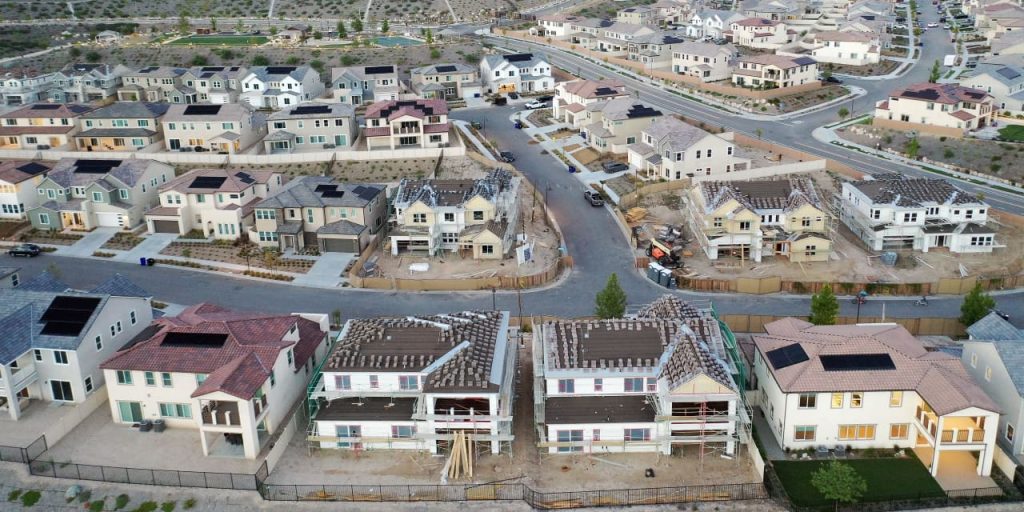PulteGroup,
the nation’s fourth largest public builder, reported quarterly earnings that beat Wall Street expectations. Shares fell after the company said it would see fewer home closings for the full year than it expected.
PulteGroup
(ticker: PHM) earned $2.90 a share on revenue of about $4 billion, roughly $3.9 billion of which came from home sales. Wall Street expected $2.83 a share on revenue of about $4.1 billion in the third quarter, higher than same-quarter 2022 earnings of $2.69 a share on $3.9 billion in revenue, according to
FactSet.
PulteGroup said it received 7,065 new orders and closed 7,076 home sales, with a home sale gross margin of 29.5%. New orders were higher than expected, but closings were lower than FactSet consensus had anticipated. The company said it expects about 8,000 closings in the fourth quarter—lower than the 8,330 expected by FactSet consensus estimates.
The fourth quarter guidance is “based on the homes we have in production—and, as importantly, current sales trends,” Bob O’Shaughnessy, PulteGroup’s chief financial officer, said on an earnings conference call. Such a result would lead to 29,000 full-year closings, the company said, down from its previous guide for 29,500 closings.
“The change in our guide reflects the more challenging affordability conditions resulting from higher rates, as well as the slight shift in our mix toward build-to-order homes, which won’t deliver until 2024,” Bob O’Shaughnessy, PulteGroup’s chief financial officer, said on the call.
Share prices in pre-market trading fell shortly after the company discussed its revised guidance on the call. Shares are up 1.1% in morning trading, and have gained 54% so far this year.
Weekly measures of mortgage rates have been on an upward climb in the second half of the year, passing 7% in August and broadly gaining since then. The gains weighed on sales of existing homes, which make up the bulk of all home purchase transactions, in September.
The National Association of Realtors’ measure of completed transactions in September fell to its lowest monthly figure since late 2010, the trade group said last week.
But the increase in mortgage rates likely won’t hit new home sales the same way. Pending-home sales, a measure of deals for previously owned homes that have not yet closed, are expected to have fallen 1.5% in September to their lowest level on record. A comparable measure of new-home contract signings is expected to have increased 0.7% to a level about 20% higher than one year prior. Both reports are expected later this week.
It isn’t that builders, the previous beneficiaries of buyer demand in a supply-constrained housing market, are immune from the impact of rising mortgage rates. Industry confidence measured by the National Association of Home Builders fell in October to its lowest level since January.
Rather, sales volume could come at the expense of builder margins. While homeowners with ultralow mortgage rates can choose not to sell instead of lowering prices or otherwise courting a buyer, builders turn to price cuts and incentives, such as mortgage rate buy-downs, to keep homes selling.
Indeed, recent reports suggest more builders are offering incentives to get prospective buyers into homes. In a survey of builders by the home builders trade group, 30% said they cut home prices in October. A larger share, roughly three in five, said they provided buyer incentives more broadly.
UBS
analysts John Lovallo, Spencer Kaufman, and Matthew Johnson lowered their 2024 builder estimates and price targets “to reflect the likelihood that ‘higher-for-longer’ interest rates will necessitate incremental rate buydowns and other incentives to sustain volume,” they wrote in a report last week. The analysts lowered their home building gross margin expectations by 1.4 percentage point on average.
New homes were beneficiaries of buyer demand earlier this year. As the steep increase in mortgage rates early in the pandemic kept would-be sellers in place, some home buyers turned to new-home construction, driving up industry sentiment—and builder stocks. Two exchange-traded funds tracking the home builders and related industries, the
SPDR S&P Homebuilders
ETF (XHB) and the
iShares U.S. Home Construction
ETF (ITB), hit 2023 closing highs on the first day of August.
Builder sentiment—and stocks—have sunk since then as mortgage rates have gained. The two exchange-traded funds were down about 17% and 19% since their 2023 closing highs as of Friday’s close—though they remain positive on the year.
The UBS analysts wrote they expect coming financial reports from builders to be of less importance to investors than commentary about buyer trends and the trajectory of builder gross margins. They remain positive on builders due to “a lack of existing home inventory, strong balance sheets and procurement/financing advantages relative to most private peers.”
Write to Shaina Mishkin at shaina.mishkin@dowjones.com
Read the full article here




